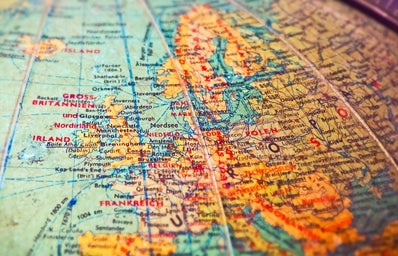The State of Education on Colonization
When thinking of colonization, many of our minds go immediately to the Americas.
We think of Columbus and other European explorers coming in and driving the Indigenous people out, eventually establishing the United States, Canada, Mexico and other countries that exist today. Colonialism is treated as a phenomenon of the past — something that we should remember, but are in no danger of repeating.
This type of thinking is not purely the fault of students. Most people stop taking history classes sometime in high school, effectively ending their education on the past in favor of computer science, biology or whatever they hope to study in college.
That said, what was learned in K-12 encompasses everything that we know about the past, and it is K-12 education that promotes this oversimplified conception of colonization, barely scratching the surface of what it consists of.
People don’t know about the colonization that has recently “ended” or what continues at the present moment. And they don’t know about the lasting effects of the legacy of colonization.
To me, it is important that we remember both the distant and recent past of colonization while acknowledging the current consequences of these actions and the present forms of colonization. This means understanding that colonization appears in different forms — we can’t look at what happened in the Americas and use it as a standard that defines all of our perceptions (though we can, of course, note similarities and patterns between different instances of colonization).
French Colonization of Algeria
One of these seldom acknowledged instances is the French colonization of Algeria, which took place from 1830 to 1962, when Algerians finally won their independence.
This was a long and complicated time, characterized by the direct rule of the French in Algeria and the settlement of French citizens in the country. However, the settlers never came to make up a majority, rather consisting of 10% of the population at the time when French rule finally came to an end.
Algerians, during the period of colonization, were treated as second class citizens, inferior to the French settlers. While all Algerians suffered, it was Muslims who faced the worst oppression.
In 1870, the French granted Algerian Jews French citizenship, but did not extend this to Muslims. Muslims, therefore, had no political power, very low economic status and faced brutal violence by the French. Until 1945, there were zero Muslims in the National Assembly and there was a major underrepresentation in local councils. Very few could vote and when finally granted that right in the 60s, their votes were unequal to those of the French, who held onto power and blocked reforms.
Algerians were also at a great disadvantage economically. The French owned a majority of the farmable land, industries and exports. They took over every profitable sector of the economy, marginalizing and excluding Algerians to such an extent that that majority of Muslims were officially considered destitute.
In the 1900s, for example, Muslims made up 90% of the population but produced only 20% of Algeria’s income — truly demonstrating their desperate economic status. Despite the fact that the French purposely excluded Muslims from anything profitable, they taxed them at the highest rates and more often. Muslims were unable to control these taxes and so they were used to benefit the French, allowing them greater access to resources and to build modern cities. Algerian Muslims saw very little, if any, of the revenue.
Throughout French colonial rule, there were many uprisings, often ending in violence. In 2017, it was estimated that 10 million Algerians were killed during the period of colonization due to massacres, the spread of diseases and famine resulting from the unequal distribution of resources.
It was not until 1962, at the end of the Algerian War, that independence was granted. 1.5 million Algerians were killed during this conflict. While many countries have declined to acknowledge this due to the potential political consequences, the actions of France did constitute a genocide.
How Brutal were the French?
I already described the French as acting violently in Algeria — but to what extent is this true? We can find countless instances of repression, cultural erasure and death due to the desolate economic condition inflicted upon Algerians and direct massacres by the French. Still, to truly mark the extreme brutality that France inflicted upon Algeria, I have compiled a list of a few notable instances of and methods French brutality:
-
Display of Sculls
In 1949, about 19 years since France first entered the country, Algerians participated in a revolt against their colonizers. The French crushed the revolt and decapitated 24 fighters, taking their heads home as trophies. These heads were displayed in a museum in Paris, solidifying the extent to which Algerians have been dehumanized by the French. Not only did they take their lives and leave their families with dismembered bodies, but created a spectacle of their sculls for the colonizers to observe.
In 2011, Algerians found out about this grotesque display when a historian came across it in the Museum of Man. He informed Algerian authorities, who requested that they be taken down and returned to their country. France refused and continued to do so over the years. In fact, it was not until approximately three months ago that France conceded to the request, allowing the sculls of these Algerians to finally be buried in their home country: it only took about 70 years.
-
Conducting of Nuclear Tests
Between 1960 and 1966, the French conducted a series of nuclear tests in Algeria. The number of tests depends on who you ask: France claimed they carried out 17, while Algerian historians state that 57 tests were conducted. No matter the reality, a total of 42,000 Algerians were killed during these tests, thousands more were injured for reasons including exposure to radioactive materials. Beyond these deaths and injuries, France’s nuclear tests reigned great environmental destruction upon Algeria’s land.
-
Internment Camps and Torture
Throughout the period of colonization, specifically during the Algerian War, the French systematically detained and tortured hundreds of thousands of Algerians in internment camps. The techniques used included electricity, sleep deprivation, starvation, waterboarding, burning and putting people in very strenuous physical positions, such as hanging them by their hands and feet, for an extended period of time. They even went as far as committing rape.
The cells were so small they often did not provide room to lay down and detainees ranged from children to the elderly, who were sometimes over 80 years old. The French military even buried elderly men alive and scores of Algerians were tortured to death.
Beyond being tortured to death, shot or buried alive, prisoners were also killed by death flights. The French military took Algerians in helicopters and dropped them into the ocean, condemning them to drown. When they realized that the dead bodies would float to the surface, they began encasing their feet in concrete to ensure that they remain at the bottom, allowing them to avoid dealing with the bodies and preventing families from burying loved ones. Survivors of French torture were faced with lifelong trauma which radically transformed their lives.
-
Massacre During Celebration of the Holocaust’s
On May 8, 1945, Algerians took the streets in celebration of the defeat of Nazi Germany. With one fascist government overturned, they took the opportunity to demand their independence.
Rather than take these pleas seriously, the French opened fire on the protestors. They murdered 45,000 people. The fact that France killed tens of thousands of people in the immediate aftermath of the brutal massacre of Jewish people, during a celebration of the massacre’s end, makes the act especially horrific.
French Intent
French officials left records of their genocidal and colonial aims in Algeria. Here are a few examples of the expressed intention:
-
One Frenchman, cited by Ben Kiernanm in “Blood and Soil,” brought up the question of what to do with the Arabs. The French debated between extermination, expulsion, enslavement and other methods of domination. This makes it very clear that the goal was to get rid of the Indigenous Arabs and replace them with French settlers.
-
Kiernmanm also cited Colonel Philibert saying that “The goal is to destroy them [Arabs], to exterminate them, to hunt them down… In leading circles, unfortunately, such things are said and even written.”
-
He cites another French author living in Algeria as saying that “we must expel and Native and if necessary destroy him.”
-
Colonel Montagnac, responsible for many massacres of Algerians, said that they intended to “destroy everything that crawl at our feet like dogs.”
Today
France has been slow to acknowledge their crimes, with President Macron only recently recognizing them and calling the colonization a “crime against humanity” and acknowleing that systemic torture occured. However, his words only scratch the surface of what atrocities have been committed. And no words can erase the lasting legacy and trauma that remains in Algeria today and will likely continue well in the future — which impacted their educational and economic infrastructure and created lasting unequal power dynamics between the Algerian Muslims, Algerians who were granted citizenship by the French and those of European descent who were never denied rights. We can, therefore, see the impacts of French colonialism in the political, socicial, and economic structures in Algeria today.


